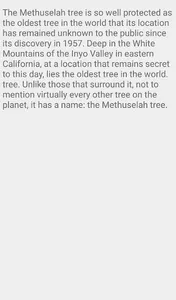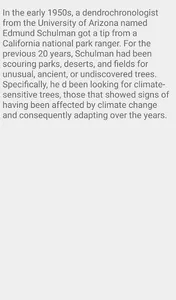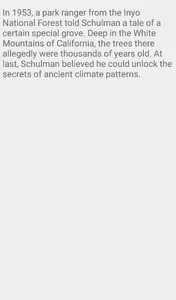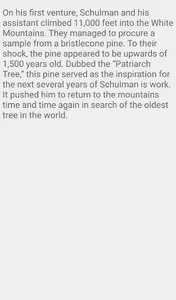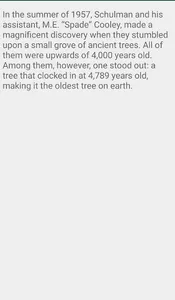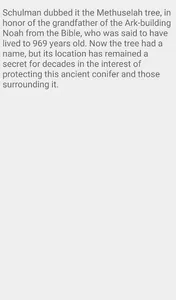Methuselah is a 4,850-year-old Great Basin bristlecone pine (Pinus longaeva) tree growing high in the White Mountains of Inyo County in eastern California. It is recognized as the tree with the greatest confirmed age in the world.
Geography
Methuselah is located between 2,900 and 3,000 m (9,500 and 9,800 ft) above sea level in the "Methuselah Grove" in the Ancient Bristlecone Pine Forest within the Inyo National Forest. Its exact location has not been publicly disclosed.
Status as oldest known tree
Methuselah was 4,789 years old when sampled (likely in 1957) by Edmund Schulman and Tom Harlan, with an estimated germination date of 2833 BC.
Other bristlecones
Another bristlecone specimen, WPN-114, nicknamed "Prometheus", was more than 4,844 years old when cut down in 1964, with an estimated germination date of 2880 BC. A dendrochronology, based on these trees and other bristlecone pine samples, extends back to about 9000 BC, albeit with a single gap of about 500 years.
An older bristlecone pine was reportedly discovered by Tom Harlan in 2009, based on a sample core collected in 1957. According to Harlan, the tree was 5,062 years old and still living in 2010. However, neither the tree nor the sample core could be located after Harlan's death in 2013.
Clonal organisms
Other, longer-lived organisms are clonal colonies, such as the 80,000-year-old quaking aspen (Populus tremuloides) colony named "Pando" in the Fish Lake National Forest in south-central Utah; the 11,700-year- old creosote bush (Larrea tridentata) colony, named "King Clone", in the Mojave Desert near the Lucerne Valley in California; and the 9,500-year-old Norway spruce (Picea abies) colony named "Old Tjikko" in Sweden. Methuselah, however, is the oldest known non-clonal organism.
Geography
Methuselah is located between 2,900 and 3,000 m (9,500 and 9,800 ft) above sea level in the "Methuselah Grove" in the Ancient Bristlecone Pine Forest within the Inyo National Forest. Its exact location has not been publicly disclosed.
Status as oldest known tree
Methuselah was 4,789 years old when sampled (likely in 1957) by Edmund Schulman and Tom Harlan, with an estimated germination date of 2833 BC.
Other bristlecones
Another bristlecone specimen, WPN-114, nicknamed "Prometheus", was more than 4,844 years old when cut down in 1964, with an estimated germination date of 2880 BC. A dendrochronology, based on these trees and other bristlecone pine samples, extends back to about 9000 BC, albeit with a single gap of about 500 years.
An older bristlecone pine was reportedly discovered by Tom Harlan in 2009, based on a sample core collected in 1957. According to Harlan, the tree was 5,062 years old and still living in 2010. However, neither the tree nor the sample core could be located after Harlan's death in 2013.
Clonal organisms
Other, longer-lived organisms are clonal colonies, such as the 80,000-year-old quaking aspen (Populus tremuloides) colony named "Pando" in the Fish Lake National Forest in south-central Utah; the 11,700-year- old creosote bush (Larrea tridentata) colony, named "King Clone", in the Mojave Desert near the Lucerne Valley in California; and the 9,500-year-old Norway spruce (Picea abies) colony named "Old Tjikko" in Sweden. Methuselah, however, is the oldest known non-clonal organism.
Show More

